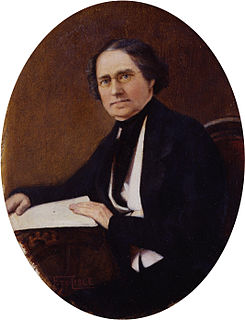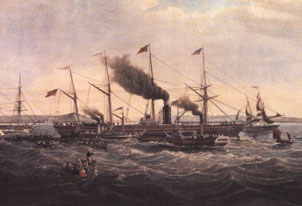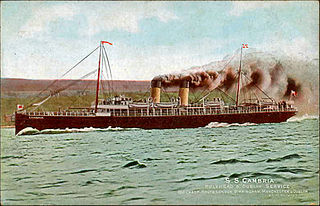
Professor Dionysius Lardner FRS FRSE was an Irish scientific writer who popularised science and technology, and edited the 133-volume Cabinet Cyclopædia.
The Chester and Holyhead Railway was an early railway company conceived to improve transmission of Government dispatches between London and Ireland, as well as ordinary railway objectives. Its construction was hugely expensive, chiefly due to the cost of building the Britannia Tubular Bridge over the Menai Strait. The company had relied on Government support in facilitating the ferry service, and this proved to be uncertain. The company opened its main line throughout in 1850. It relied on the co-operation of other railways to reach London and in 1859 it was absorbed by the London and North Western Railway.
The shipping company is an outcome of the development of the steamship. In former days, when the packet ship was the mode of conveyance, combinations, such as the well-known Dramatic and Black Ball lines, existed but the ships which they ran were not necessarily owned by the organizers of the services. The advent of the steamship changed all that.

The City of Dublin Steam Packet Company was a shipping line established in 1823. It served cross-channel routes between Britain and Ireland for over a century. For 70 of those years it transported the mail. It was 'wound-up' by a select committee of the House of Lords in 1922 and finally liquidated in 1930.
George Forrester and Company was a British marine engine and locomotive manufacturer at Vauxhall Foundry in Liverpool, established by Scottish engineer George Forrester. The company opened in 1827 as iron founders and commenced building steam locomotives in 1834.

SS Sirius was a wooden-hulled sidewheel steamship built in 1837 by Robert Menzies & Sons of Leith, Scotland for the London-Cork route operated by the Saint George Steam Packet Company. The next year, she opened transatlantic steam passenger service when she was chartered for two voyages by the British and American Steam Navigation Company. By arriving in New York a day ahead of the Great Western, she is usually listed as the first holder of the Blue Riband, although the term was not used until decades later.

The Great Western Steam Ship Company operated the first regular transatlantic steamer service from 1838 until 1846. Related to the Great Western Railway, it was expected to achieve the position that was ultimately secured by the Cunard Line. The firm's first ship, Great Western was capable of record Blue Riband crossings as late as 1843 and was the model for Cunard's Britannia and her three sisters. The company's second steamer, the Great Britain was an outstanding technical achievement of the age. The company collapsed because it failed to secure a mail contract and Great Britain appeared to be a total loss after running aground. The company might have had a more successful outcome had it built sister ships for Great Western instead of investing in the too advanced Great Britain.
TSS Mellifont was a twin screw passenger steamship operated by the Lancashire and Yorkshire Railway from 1903 to 1928.

TSS Scotia was a twin screw steamer passenger vessel operated by the London and North Western Railway from 1902 to 1923.

TSS Cambria was a twin screw steamer passenger vessel operated by the London and North Western Railway from 1897 to 1923.
PS Sea Nymph was a paddle steamer passenger vessel operated by the London and North Western Railway from 1856 to 1876.
PS Scotia was a paddle steamer passenger vessel operated by the Chester and Holyhead Railway from 1847 to 1858, and the London and North Western Railway from 1859 to 1861.
PS Hibernia was a paddle steamer passenger vessel operated by the Chester and Holyhead Railway from 1847 to 1859 and the London and North Western Railway from 1859 to 1877.
PS Alexandra was a paddle steamer passenger vessel operated by the London and North Western Railway from 1863 to 1889.
PS/TSS Edith was a paddle steamer cargo vessel operated by the London and North Western Railway from 1870 to 1912.

PS Hercules was a paddle steamer vessel operated by the St. George Steam Packet Company from 1836, and then the Chester and Holyhead Railway from 1853 to 1859 and the London and North Western Railway from 1859 to 1862.

SS or RMS The Ramsey was a passenger steamer operated by the Isle of Man Steam Packet Company from 1912 to 1914. She had been built in 1895 as Duke of Lancaster for the joint service to Belfast of the London and North Western Railway and Lancashire and Yorkshire Railway companies. The steamer was requisitioned by the Admiralty in 1914 as the armed boarding vessel HMS Ramsey and sunk the following year.
The California Steam Navigation Company was formed in 1854 to consolidate competing steamship companies in the San Francisco Bay Area and on the Sacramento and San Joaquin Rivers. It was successful in this effort and established a profitable near-monopoly which it maintained by buying out or bankrupting new competitors. In response to the Fraser Canyon gold rush and economic growth in the Pacific Northwest, the company expanded to ocean routes from San Francisco north to British Columbia. Similarly, as California's economy grew, the company offered service from San Francisco south to San Pedro and San Diego. It exited these markets in 1867 when competition drove prices to unprofitable levels. While the California Steam Navigation Company was successful throughout its life in suppressing steamboat competition on its core Bay Area and river routes, it could not control the rise of railroads. These new competitors reduced the company's revenue and profit. Finally, in 1871, the company's assets were purchased by the California Pacific Railroad, and the corporation was dissolved.
SS Kilkenny was a passenger vessel built for the City of Dublin Steam Packet Company in 1903.
Water Witch was an early British wood-hulled paddle steamer, built in 1835 at Harwich, England for steam packet services from Dover to London and to Boulogne. A successful fast ship, she was later operated on services on the South Coast of England and in the Bristol Channel







